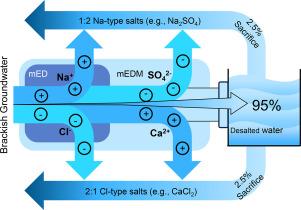Extending the applicability of modified electrodialysis metathesis for high-recovery desalination by improving concentrate separation and monovalent ion retention
IF 9.8
1区 工程技术
Q1 ENGINEERING, CHEMICAL
引用次数: 0
Abstract
This study presents a two-step desalination process integrating monovalent-selective electrodialysis (mED) and modified electrodialysis metathesis (mEDM) to achieve high-recovery, chemical-free desalination, even in waters with high scaling potential. In the first step, mED extracts NaCl from the feedwater. The extracted NaCl is then used in the mEDM step to recombine the Na+ with multivalent anions (SO₄2−) from the feed water into a separate concentrate, and the Cl− with multivalent cations from (Ca2+, Mg2+) the feed water into another concentrate. This way the feed gets desalted, and scaling of sparingly soluble salts such as CaSO₄ in the concentrates is prevented. Experiments with synthetic NaCl–MgSO₄ solutions showed that this process scheme outperformed conventional electrodialysis (ED), reverse osmosis (RO), and previously tested stand-alone mEDM, with scaling tendencies remaining far below saturation obtained by the other technologies. The system was then validated using brackish groundwater and (saline) oilfield produced water. For groundwater, it achieved 95 % water recovery with no scaling risk and reasonable energy consumption (∼1.32 kWh/m3), potentially reaching 97.5 % recovery via theoretical simulation. For produced water with a 2:1 monovalent/divalent ion ratio—near the stoichiometric limit—the process maintained performance, although NaCl depletion and impurity buildup in the intermediate solution emerged as limiting factors. To support continuous operation, we propose some simple interventions to enable long-term stability and scalability. Overall, this two-step mED–mEDM configuration offers a robust, modular, and fully electrically-driven approach for chemical-free desalination, with a minimum of extra energy consumption. It holds strong potential for integration into existing systems—such as treating RO retentates—and could support high-recovery, low-footprint water treatment applications.

通过改善精矿分离和提高单价离子保留率,扩大改良电渗析复分解在高回收海水淡化中的适用性
本研究提出了一种结合单价选择性电渗析(mED)和改良电渗析复分解(mEDM)的两步脱盐工艺,以实现高回收率、无化学物质的脱盐,即使在具有高结垢潜力的水中也是如此。第一步,mED从给水中提取NaCl。然后在mEDM步骤中使用提取的NaCl将进水中的Na+与多价阴离子(SO₄2 -)重新组合成一个单独的浓缩物,将进水中的Cl -与多价阳离子(Ca2+, Mg2+)重新组合成另一个浓缩物。通过这种方式,饲料得到脱盐,精矿中难溶盐(如硫酸钙)结垢也得到了防止。合成NaCl-MgSO₄溶液的实验表明,该工艺方案优于传统的电渗析(ED)、反渗透(RO)和先前测试过的独立mEDM,结垢倾向远低于其他技术所获得的饱和。然后,使用微咸地下水和(含盐)油田采出水对该系统进行了验证。对于地下水,它实现了95%的水回收率,没有结垢风险和合理的能源消耗(~ 1.32 kWh/m3),通过理论模拟可能达到97.5%的回收率。对于单价/二价离子比为2:1(接近化学计量极限)的采出水,尽管NaCl损耗和中间溶液中的杂质积聚成为限制因素,但该工艺仍保持了性能。为了支持持续操作,我们提出了一些简单的干预措施,以实现长期稳定性和可伸缩性。总的来说,这种两步mED-mEDM配置提供了一种强大的、模块化的、完全由电力驱动的方法,用于无化学物质的海水淡化,同时将额外的能源消耗降至最低。它具有与现有系统集成的强大潜力,例如处理反渗透截留物,并且可以支持高回收率,低足迹的水处理应用。
本文章由计算机程序翻译,如有差异,请以英文原文为准。
求助全文
约1分钟内获得全文
求助全文
来源期刊

Desalination
工程技术-工程:化工
CiteScore
14.60
自引率
20.20%
发文量
619
审稿时长
41 days
期刊介绍:
Desalination is a scholarly journal that focuses on the field of desalination materials, processes, and associated technologies. It encompasses a wide range of disciplines and aims to publish exceptional papers in this area.
The journal invites submissions that explicitly revolve around water desalting and its applications to various sources such as seawater, groundwater, and wastewater. It particularly encourages research on diverse desalination methods including thermal, membrane, sorption, and hybrid processes.
By providing a platform for innovative studies, Desalination aims to advance the understanding and development of desalination technologies, promoting sustainable solutions for water scarcity challenges.
 求助内容:
求助内容: 应助结果提醒方式:
应助结果提醒方式:


